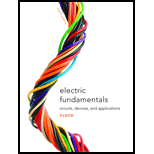
Electronics Fundamentals: Circuits, Devices & Applications
8th Edition
ISBN: 9780135072950
Author: Thomas L. Floyd, David Buchla
Publisher: Prentice Hall
expand_more
expand_more
format_list_bulleted
Concept explainers
Textbook Question
Chapter 21, Problem 10P
Explain how a strain gauge can be used to measure pressure.
Expert Solution & Answer
Want to see the full answer?
Check out a sample textbook solution
Students have asked these similar questions
!.With the aid of a diagram explain bourdon gauge and how it works
!!. Explain the principle of operation of the electrical resistance strain gauge
What are the different types of IC voltage regulators? Explain each one work's.
An AC ammeter is connected in series with the primary winding of T1. What is the expected current reading?
An AC ammeter is connected in series with the secondary winding of T1. What is the expected current reading?
An AC ammeter is connected in series with R1. What is the expected current reading?
NOTE: Idc for HW rectifier = 0.318 * Ipeak = 0.45 * Irms
Describe/Explain briefly the purpose/use of the array (series-parallel) connection of the rectifier diodes in the given circuit.
Chapter 21 Solutions
Electronics Fundamentals: Circuits, Devices & Applications
Ch. 21 - A thermocouple can measure higher temperatures...Ch. 21 - Thermocouples are commonly used to measure body...Ch. 21 - An advantage of an RTD over a thermistor is that...Ch. 21 - Prob. 4TFQCh. 21 - A thermocouple signal conditioner must have high...Ch. 21 - Signal conditioning for temperature sensors...Ch. 21 - Prob. 7TFQCh. 21 - Absolute pressure is measured relative to the...Ch. 21 - In a sample-and-hold circuit, an analog value is...Ch. 21 - Prob. 10TFQ
Ch. 21 - A thermocouple a change in resistance for a change...Ch. 21 - In a thermocouple circuit, where each of the...Ch. 21 - A thermocouple signal conditioner is designed to...Ch. 21 - Prob. 4STCh. 21 - Prob. 5STCh. 21 - Prob. 6STCh. 21 - Prob. 7STCh. 21 - Prob. 8STCh. 21 - Prob. 9STCh. 21 - Prob. 10STCh. 21 - Prob. 11STCh. 21 - Prob. 12STCh. 21 - Prob. 13STCh. 21 - Prob. 14STCh. 21 - In an analog switch, the aperture time is the time...Ch. 21 - Prob. 16STCh. 21 - An analog signal must be sampled at a minimum rate...Ch. 21 - Prob. 18STCh. 21 - Prob. 19STCh. 21 - Prob. 20STCh. 21 - Prob. 21STCh. 21 - Three identical thermocouples are each exposed to...Ch. 21 - You have two thermocouples. One is a K type and...Ch. 21 - Determine the output voltage of the op-amp in...Ch. 21 - What should be the output voltage in Problem 3 if...Ch. 21 - Prob. 5PCh. 21 - Prob. 6PCh. 21 - Explain the difference in the results of Problems...Ch. 21 - Prob. 8PCh. 21 - A certain material being measured undergoes a...Ch. 21 - Explain how a strain gauge can be used to measure...Ch. 21 - Identify and compare the three symbols in Figure...Ch. 21 - Determine the output voltage waveform for the...Ch. 21 - Repeat Problem 12 for the waveforms in Figure...Ch. 21 - Name two ways an SCR can be placed in the...Ch. 21 - Sketch the VR waveform for the circuit in Figure...Ch. 21 - For the circuit in Figure 21-53, describe the...Ch. 21 - What change to the circuit in Figure 21-53 would...
Knowledge Booster
Learn more about
Need a deep-dive on the concept behind this application? Look no further. Learn more about this topic, electrical-engineering and related others by exploring similar questions and additional content below.Similar questions
- Fill in the blanks: Given the model for position control system, find the value for K1 and K2 so that the peak time is equal to 0.5 s and the %OS is equal to 3%. K1= 93.2070 K2= 0.129 I 446 23arrow_forwardWhy is high pressure needed in HPLC?arrow_forwardDefine Calibration. Also, Explain the Calibration procedures for a Energy Meter.arrow_forward
- Equal area criterion gives the information regarding Stability region swing curves relative stability absolute stabilityarrow_forwardQ1 (i) What is an LVDT and what is it used for? (ii) Describe the construction features of an LVDT. Q2 (i) What is a strain gauge and what is it used for? (ii) What is the principle of operation of a strain gauge? (iii) Describe some applications of strain gauges.arrow_forwardQuestion (2) A controlled half-wave rectifier has a 240 V rms 60Hz ac source, The load a is R=30 Ohm resistor (a) Determine the delay angle such that the average load current is 2.5A (b) Determine the power absorbed by the load (c) Determine the power factor.arrow_forward
- Explain the operation of a full subtractor with necessary diagrams. What is the differencebetween half and full subtractor?arrow_forwardExplain the operation of a full-wave bridge rectifier with proper diagram. answer show step by step i will upvote youarrow_forward1) The following is not an example of a Thyristor a) A Silicon Unilateral Switch b) A TRIAC c) A Silicon Controlled Rectifier d) Amorphous Limpid Trilateral Rodomontadearrow_forward
- Explain the operation of an analog voltmeter.arrow_forwardShow your solution If a half-wave rectifier is used with 117-V rms ac (house mains), the average dc output voltage is about:arrow_forward1a.With the aid of a diagram, briefly explain the piezoelectric force transducer and how it works. 1b. With the aid of a diagram explain the bourdon gauge and how it works. 1c. Explain the principle of operation of how the electrical resistance strain gauge.arrow_forward
arrow_back_ios
SEE MORE QUESTIONS
arrow_forward_ios
Recommended textbooks for you
 Electricity for Refrigeration, Heating, and Air C...Mechanical EngineeringISBN:9781337399128Author:Russell E. SmithPublisher:Cengage Learning
Electricity for Refrigeration, Heating, and Air C...Mechanical EngineeringISBN:9781337399128Author:Russell E. SmithPublisher:Cengage Learning

Electricity for Refrigeration, Heating, and Air C...
Mechanical Engineering
ISBN:9781337399128
Author:Russell E. Smith
Publisher:Cengage Learning
Electrical Measuring Instruments - Testing Equipment Electrical - Types of Electrical Meters; Author: Learning Engineering;https://www.youtube.com/watch?v=gkeJzRrwe5k;License: Standard YouTube License, CC-BY
01 - Instantaneous Power in AC Circuit Analysis (Electrical Engineering); Author: Math and Science;https://www.youtube.com/watch?v=If25y4Nhvw4;License: Standard YouTube License, CC-BY